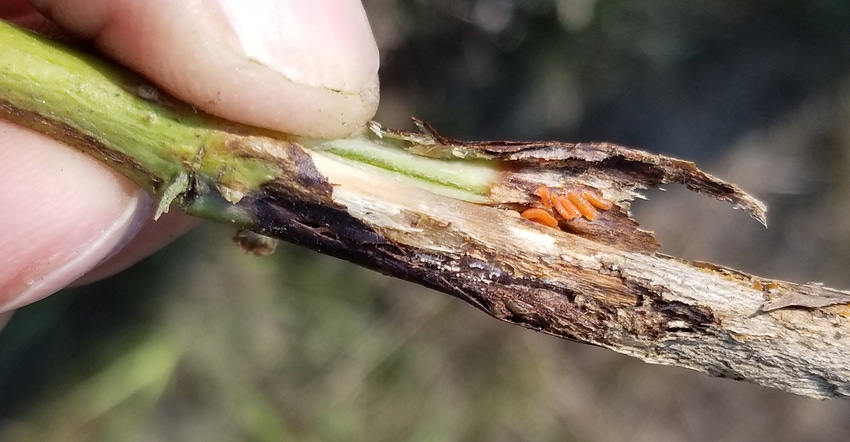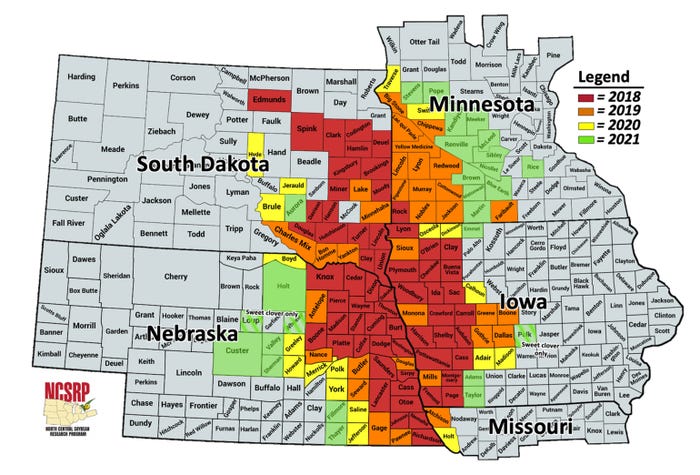
University of Minnesota Extension entomologists and crop specialists ask that farmers continue to scout soybean fields for soybean gall midge.
The small orange-red-colored maggots, found under the soybean epidermis near the base of the plant, have been found on soybean plants in 140 counties in Minnesota, South Dakota, Nebraska, Iowa and Missouri. Twenty-six counties were added this year, with three reporting larvae only on sweet clover.
Reports of soybean gall midge findings are updated on the regional Soybean Gall Midge Alert Network, managed by the University of Nebraska Extension.
Minnesota saw the greatest soybean gall midge spread this year among the five states, with the pest found in 13 counties for the first time. That said, crop injury this season in the state from soybean gall midge has been less than previous years, according to Bruce Potter, integrated pest management specialist with the University of Minnesota Extension.
“As the second larval generation developed during late July and August 2021, infestations became easier to locate,” Potter says. “These new county infestations were not at high soybean gall midge population densities.”
 MIDGE’S SPREAD: Soybean gall midge has been documented in 140 counties across five states as of Aug. 31. Twenty-six counties were added to the list this year.
MIDGE’S SPREAD: Soybean gall midge has been documented in 140 counties across five states as of Aug. 31. Twenty-six counties were added to the list this year.

It is not known how the drought may have impacted the spread of soybean gall midge in the state.
“The effect is not clear, but it may have reduced colonization success at mating, egg laying or larval survival,” Potter says.
Most of those new midge detections did not show symptoms of dead or wilted plants to provide clues, he adds.
“We needed to look for symptoms at the base of stems beneath normal appearing canopies,” Potter says. “In some cases, brittle stems resulting from soybean gall midge injury made finding the larvae easier; but even then, only a few infested plants were found in these fields.”
In a recent e-newsletter, Potter credited a sharp-eyed farmer in Traverse County with finding soybean gall midge in mid-August by inspecting a single plant with a broken stem in one of his fields.
Soybean gall midge has also been observed in Minnesota on the alternate host sweet clover. Potter says the pest can be found there — and to lesser extent, on alfalfa.
“Minnesota is conducting some field studies and a survey to look at dry beans and other cultivated legumes as alternate hosts,” Potter adds. In a free-choice environment, the midge prefers soybeans as the host.
Researchers were still capturing emerging soybean gall midge adults in mid-August, so Potter expects soybean death and stem breakage to continue for a few weeks. He asks that growers contact him or U-M Extension entomologist Rob Koch, especially if they find the midge in a Minnesota county where it has not yet been confirmed.
“From a distance, soybean plants killed by the soybean gall midge can resemble those killed by white mold, but are generally located at the field edge,” Potter says. “As harvest approaches, if you notice areas of dead or lodged soybeans with brittle lower stems on the edge of your fields, it could very well be caused by soybean gall midge.”
Management, research
At this time, there are no management strategies recommended for soybean gall midge. Screening for resistant varieties is being done in Nebraska, Iowa and South Dakota, Potter says. Insecticide and cultural work also is being done in Nebraska and Iowa.
“Because we have not yet been able to maintain a laboratory colony, it has been hard to work on some of the basic biology issues, such as temperature-dependent development and identifying mating and aggregation pheromones,” Potter says. Research is being done in Koch’s lab to identify biological control for the soybean gall midge, he adds.
What scientists know
According to U-M Extension information, entomologists are in the early stages of understanding soybean gall midge biology. The larvae are believed to overwinter inside cocoons in the soil of infested fields, with pupation and adult emergence occurring in the spring. Adults begin to emerge in June. Emergence of adults is prolonged and can extend into July.
Although reproductive behaviors are not yet known, egg laying is suspected to occur near the base of plants, where larval infestations are typically found. Cracks in the stem epidermis and other wounds may provide sites for egg deposition or larval entry. There are at least two adult generations each year in Minnesota.
Natural enemies of the soybean gall midge may occur but have not been documented.
Plant symptoms and larval infestations are visible after the V2 soybean growth stages. Larvae occur under the epidermis of the soybean stem, typically at the base of the plants. Larval feeding causes blackened areas at the base of the stem, with heavily infested areas of stems deformed and necrotic. Stems can lodge or break easily at these areas. Injury can result in stunting, wilting and death of soybean plants. Significant yield reductions have been recorded, especially on field edges.
Seed-applied insecticides do not appear to be effective. Application of foliar insecticides could be an option in the future, but insecticide efficacy and application timing need to be studied. Extended emergence and multiple generations could make insecticide control of adults difficult.
If host plant resistance can be identified, varieties resistant to soybean gall midge could be a valuable management tool.
To report a finding of soybean gall midge, contact Potter at [email protected], or Koch at [email protected].
Infestations can be confirmed with a photo and field location. Updated distribution maps, gall midge adult emergence and other information is available at soybeangallmidge.org.
Learn more about the pest online.
Checkoff dollars through the North Central Soybean Research Program and Minnesota Soybean Research and Promotion Council help support soybean gall midge surveys.
About the Author(s)
You May Also Like






